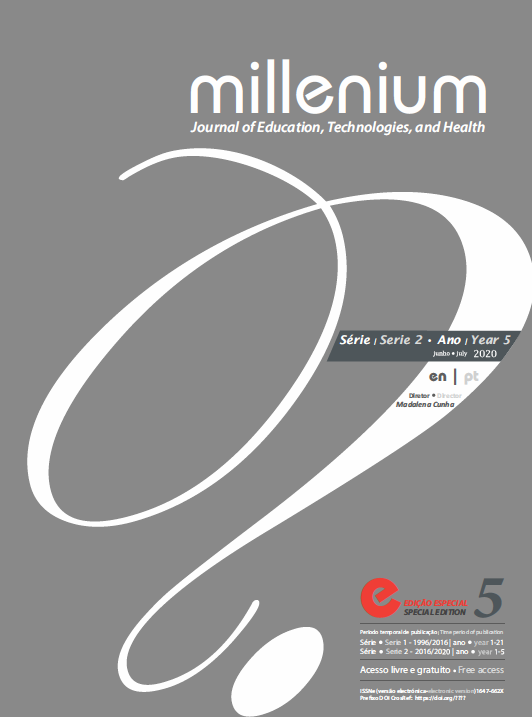Pain management in nursing practice in the emergency department
DOI:
https://doi.org/10.29352/mill0205e.29.00257Keywords:
pain, pain management, evidence-based practiceAbstract
Introduction: In Portugal, more than 30% of adults have chronic pain and acute pain is the main reason for hospital admission, representing 5 billion euros annually, 2.7% of Gross Domestic Product.
Objetives: Assess the practices and factors involved in pain management by nurses in an Emergency Department.;
Methods: Cross-sectional, analytic study, conducted in an emergency setting. Sample consisted of 96 nurses. The data collection instrument contained questions of socio-professional characterisation, the Scale of Nursing Practices in Pain Management of Catarina António and the Visual Pain Code of Grünenthal.
Results: The pain assessment scale most commonly used by nurses was the Numerical Rating Scale (88.5%); nurses with more experience in the Emergency Department (>=11 years) showed a greater lack of knowledge (37.5%) and the majority (53.8%) of those with good knowledge about this code worked between 6-10 years (p=0.021).
Conclusions: We believe that nurses need to deepen their knowledge about the principles of pain assessment and management. The constant and targeted updating of training will contribute to a better daily clinical practice.
Downloads
References
Allen, E., Williams, A., Jennings, D., Stomski, N., Goucke, R., Toye, C., & McCullough, K. (2018). Revisiting the Pain Resource Nurse Role in Sustaining Evidence-Based Practice Changes for Pain Assessment and Management. Worldviews Evid Based Nurs, 15(5), 368-376. DOI:10.1111/wvn.12318
Almeida, V. (2015). A avaliação da dor no doente cirúrgico com alterações cognitivas. Viseu: Instituto Politécnico de Viseu. Escola Superior de Saúde de Viseu.Acedido em http://repositorio.ipv.pt/bitstream/10400.19/3052/1/ALMEIDA%2C%20VeraLuciaBarbosa%20DM.pdf
António, C., Santos, E., Cunha, M., & Duarte, J. (2019). Estudo psicométrico da Escala de Práticas de Enfermagem na Gestão da Dor. Revista Referência.
APED. (2013). Declaração de Montreal. Retrieved from Associação Portuguesa para o Estudo da Dor: http://www.aped-dor.com/index.php/a-aped/declaracao-de-montreal.html
Azevedo, L., Costa-Pereira, A., Mendonça, L., Dias, C., & Castro-Lopes, J. (2016). The economic impact of chronic pain: a nationwide population-based cost-of-illness study in Portugal. Eur J Health Econ, 17(1), 87-98. DOI:10.1007/s10198-014-0659-4
Azevedo, L., Costa-Pereira, A., Mendonças, L., Dias, C., & Castro-Lopes, J. (2018). Epidemiology of chronic pain: a population-based nationwide study on its prevalence, characteristics and associated disability in Portugal. J Pain, 13(8),773-83. DOI:10.1016/j.jpain.2012.05.012
Cardoso, A. (2013). Manual de Tratamento da Dor. Lisboa: Lidel.
Carvalho, M. (2016). O Sistema de Triagem de Manchester e a avaliação da pessoa com dor. Coimbra: Escola Superior de Enfermagem de Coimbra. Acedido em repositorio.ipv.pt/bitstream/...19/.../ALMEIDA%2C%20VeraLuciaBarbosa%20DM.pd.
Curtis , L., & Morrell, T. D., T. (2006). Pain management in the emergency department. Emergency Medicine Practice, 8(7), 1-28.
Decosterd , I., Hugli, O., Tamchès, E., Blanc, C., Mouhsine, E., & Givel, J. (2007). Oligoanalgesia in the emergency department: Short-term beneficial effects of an education program on acute pain. Annals of Emergency Medicin, 50(4), 462-471.
DGS (2003). Circular normativa nº 9/DGCG: A dor como 5º sinal vital. Registo sistemático da intensidade da dor. Direção-Geral da Saúde.
DGS (2013). Plano estratégico nacional de prevenção e controlo da dor (PENPCDor). Direção-Geral da Saúde. Acedido em http://www.dgs.pt/outros-programas-e-projetos/paginas-de-sistema/saude-de-a-a-z/plano-estrategico-nacional-de-prevencao-e-contr
Ferreira, L. (2013). Prevalência de Dor em Emergência Pré-Hospitalar. Viseu: Instituto Politécnico de Viseu - Escola Superior de Saúde de Viseu.
Ferreira, N., Miranda, C., Leite, A., Revés, L., Serra, I., Fernandes, A., & Freitas, P. (2014). Pain and Analgesia in Critical Illness. Rev Clin Hosp Prof Dr Fernando Fonseca, 2(2), 17-20.
Germossa, G., Sjetne, I., & Helleso, R. (2018). The Impact of an In-service Educational Program on Nurses’ Knowledge and Attitudes Regarding Pain Management in an Ethiopian University Hospital. Frontiers in Public Health, 6, 229, 1-7.
Gouveia, M., & Augusto, M. (2011). Indirect costs of chronic pain. Rev Port Saúde Pública, 29(2), 100-107.
Grant, M., Ferrel, B., Hanson, J., Sun, V., & Uman, G. (2011). The enduring need for the pain resource nurse (PRN) training program. J Cancer Educ, 26(4):598-603. DOI:10.1007/s13187-011-0268-1
Grunenthal. (s.d). Código Visual da Dor de Grunenthal. Algés: Grünenthal S.A. Portugal.
International Association for the Study of Pain. (2018). IASP - International Association for the Study of Pain. Acedido em https://www.iasp-pain.org/Education/Content.aspx?ItemNumber=1698#Pain
International Council of Nurses (2011). CIPE - Classificação Internacional para a Prática de Enfermagem Versão 2. Genebra: Ordem dos Enfermeiros.
Marôco, J. (2018). Análise Estatística com o SPSS Statistics (7 ed.). Pêro Pinheiro: ReportNumber.
Motov, S. (2012). Acute Pain Management in the Emergency Department: The Evidence‐Based Approach to Controversial Issues. EMedHome.
Ordem dos Enfermeiros. (2008). Dor - Guia Orientador de Boa Prática. Lisboa: Ordem dos Enfermeiros. Acedido em https://www.ordemenfermeiros.pt/arquivo/publicacoes/Documents/cadernosoe-dor.pdf
Pestana, M., & Gagueiro, J. (2014). Análise de dados para Ciências Sociais - A complementariedade do SPSS (6 ed.). Lisboa: Sílabo.
Pines, J., & Hollander, J. (2008). Emergency department crowding is associated with poor care for patients with severe pain. Annals of Emergency Medicin, 51(1), 1-5.
Simon, B., Scallan, E., Carrol, G., & Steagall, P. (2017). The lack of analgesic use (oligoanalgesia) in small animal practice. J Small Anim Pract, 58(10):543-554. DOI:10.1111/jsap.12717
Downloads
Published
How to Cite
Issue
Section
License
Authors who submit proposals for this journal agree to the following terms:
a) Articles are published under the Licença Creative Commons (CC BY 4.0), in full open-access, without any cost or fees of any kind to the author or the reader;
b) The authors retain copyright and grant the journal right of first publication, allowing the free sharing of work, provided it is correctly attributed the authorship and initial publication in this journal;
c) The authors are permitted to take on additional contracts separately for non-exclusive distribution of the version of the work published in this journal (eg, post it to an institutional repository or as a book), with an acknowledgment of its initial publication in this journal;
d) Authors are permitted and encouraged to publish and distribute their work online (eg, in institutional repositories or on their website) as it can lead to productive exchanges, as well as increase the impact and citation of published work
Documents required for submission
Article template (Editable format)















